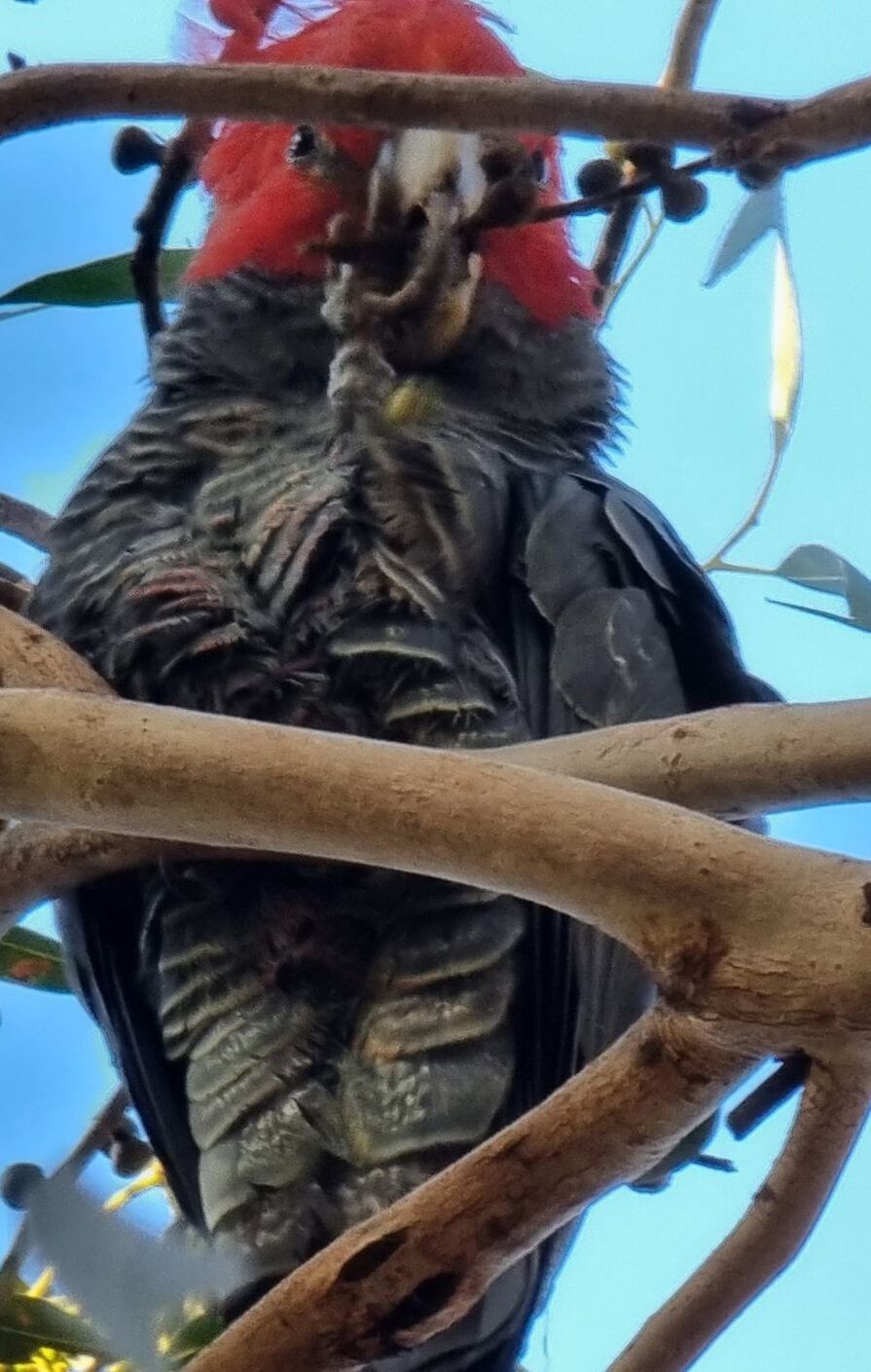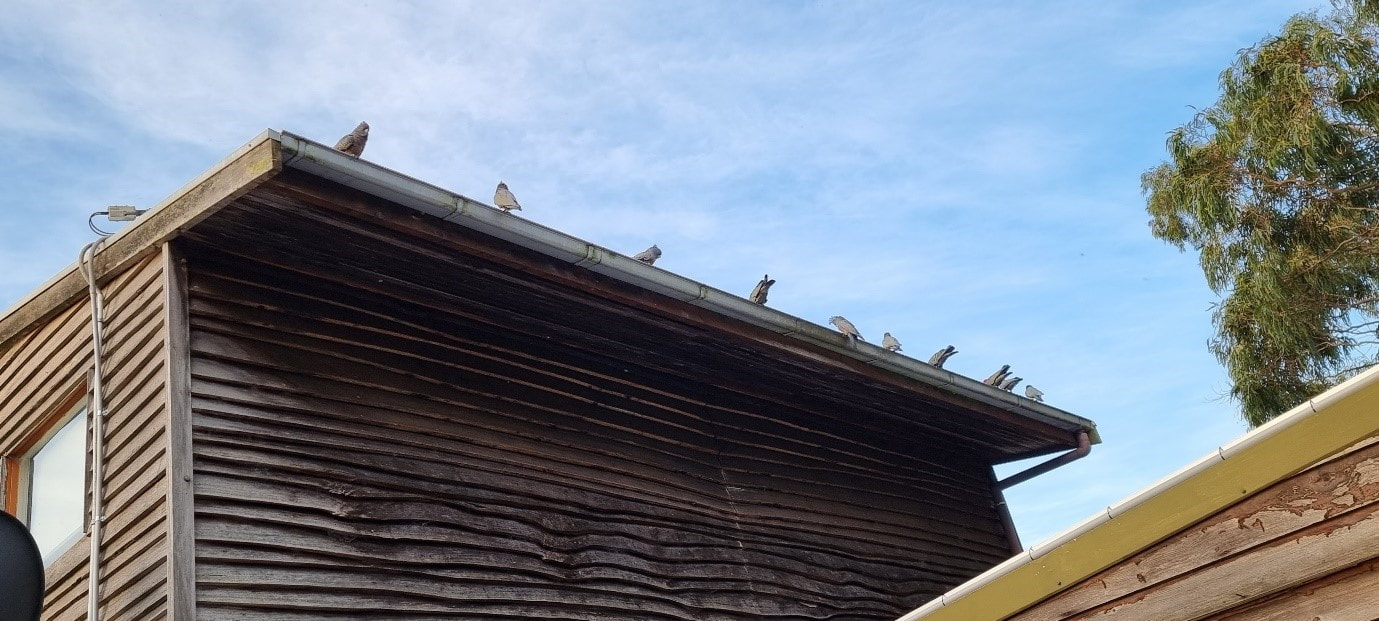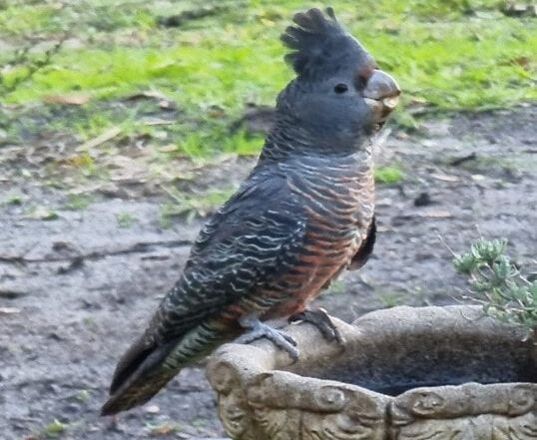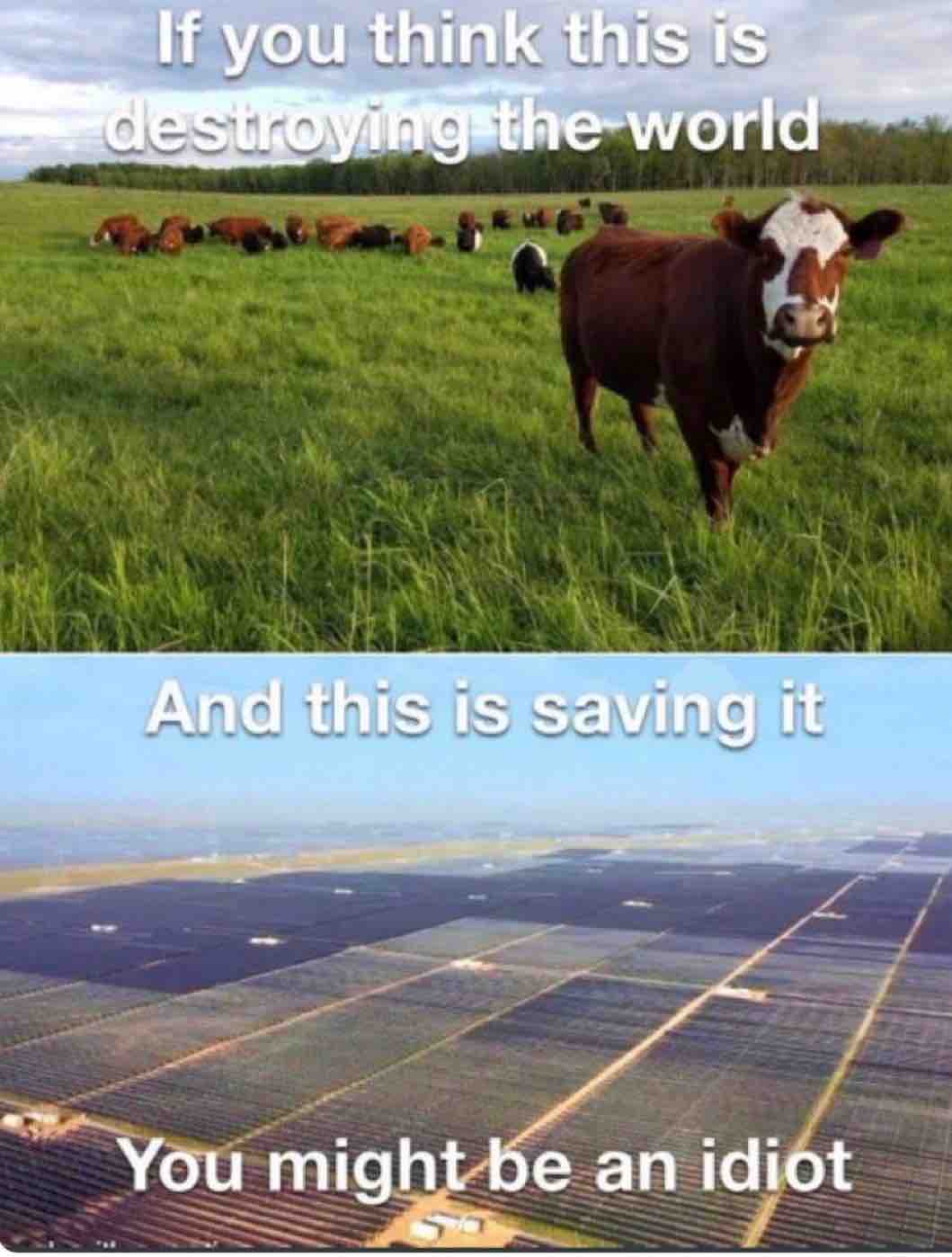The Gang-gang Cockatoo is a regular inhabitant of Gellions Run and the woodlands of Nooramunga.
Gang-gang Love - Research by Maree Avery
| gangganglove.docx | |
| File Size: | 2326 kb |
| File Type: | docx |
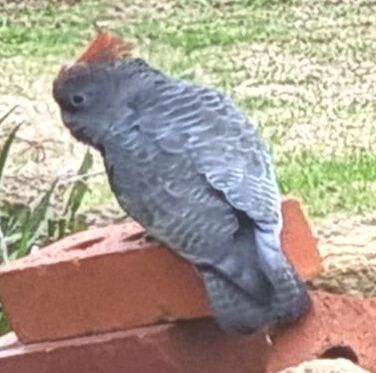
Back on the 24th April 2022, I looked out my kitchen window and saw this little bird. I have lived here all my life and I can never remember seeing this little bird, but I instantly recognised the Gang Gang Cockatoo. I had heard of people seeing this little fellow but more as an infrequent visitor along these coastal plains. I also knew that they were more an inland bird, up in the foothills. I also knew that they had recently been listed as a threatened species, but I really didn’t know that much more about this little bird.
I visited the Bird Australia website to read more about these funny little birds. What I learnt horrified me. Gang Gang Cockatoos have had a 69% decline in their population over a 30-year period prior to the 2019 -2020 bushfires. After the fires, a further 10% decline in numbers was expected. I wasn’t ready for that! I also noted that Bird Australia had a ‘Gang Gang Cockatoo Recovery e-learning Course’ to help us learn about how we can help these little birds to survive. I immediately enrolled.
|
From the first sighting of the Gang Gang in April ,I fell in love. Up until August a small flock of 15-20 Gang Gangs would arrive in my back yard every evening between 4-5 pm . With the trademark ‘creaky door’ greeting ,I was overwhelmed by their presence. Pretty soon that’s all I could talk about. Yes, ‘Gang Gang this’ and ‘Gang Gang that’. They brought a smile to my face. I told my friends and they came to experience what I had been so lucky to see. Maureen Harley, a friend and a talented photographer and artist, was also smitten with these funny little birds. Maureen would sit quietly waiting for them to arrive. During this time Maureen took my photo while I was counting the gang gangs for ‘Birdata’. A moment in time was captured. She drew an amazing portrait of me and entered the portrait in the local ‘Archies’ exhibition. Maureen didn’t win, but I know we did win, as we both got to talk about the Gang Gangs. Yes, I am their advocate. I want to protect and assist these little birds to survive. They can happily stay in my backyard. |
The bird emblem of the Australian Capital Territory is the Gang Gang Cockatoo. However, the 2019 -2020 bushfires scorched and decimated their habitat of South Eastern Australian . They live in the mountains and hills during the summer months and travel to the lower ground over the winter and spring period. They eat over 200 types of native bushes, seeds, fruits and cones, of mainly wattles and eucalyptus species. They also enjoy some introduced species of Hawthorn bushes, Cotoneaster, liquid amber and cypresses. Insects and sawfly larvae are also included in their diet. But with the 2019-2020 fires, their food source was destroyed.
In the afternoons I would hear the ‘creaky door ‘greeting and smell the eucalyptus and feel and see the chewed gumnuts and branches gently fall to the ground. I would look up and there they would be perched in their favourite tree. Forever chomping away at the gumnuts, holding the foliage in their left foot to eat. They are unlike the other cockatoos who can separate the seeds from the pods in their beak. Before too long ,I found myself talking to them. I couldn’t help myself. My camera was working overtime. And I must say I got some good photos. They seemed so tame and unafraid of me. I didn’t mind and neither did they.
Gang Gangs breed between October to January. They come to the lower grounds and find or return to the same large ‘live hollow’ year after year. The site is well chosen , usually 6-8 metres from the ground with a clear view of the hollow entry with a branch close by ,acting as a watch out position. Both parents share the nest duties, usually 2 eggs are laid with a 30-day incubation period. It is usual for a small community of birds( that is 2 families) to be in the same area. Parents feed the fledglings for 56 days, then another 4-6 weeks after leaving the nest. Nesting boxes are being trialled in East Gippsland but so far, the results are not encouraging. Therefore, it is critical to protect our nesting hollows. I am constantly looking to see if I can see where they are nesting. So far no luck.
Access to fresh water is very important, as this is where the bird is most vulnerable. I have watched them come to my two birdbaths, but I have also watched them drink from my second storey gutter. It is thought that the parents continue to feed the young bird’s water, as it is a high risk for the young birds to drink at ground level. I have also seen the birds drink from cattle troughs. Part of my plan to help these little birds is installing some more water baths high off the ground on the storage shed roof. It is important to ensure that the water is fresh as these little birds can suffer from a beak and feather virus.
In the afternoons I would hear the ‘creaky door ‘greeting and smell the eucalyptus and feel and see the chewed gumnuts and branches gently fall to the ground. I would look up and there they would be perched in their favourite tree. Forever chomping away at the gumnuts, holding the foliage in their left foot to eat. They are unlike the other cockatoos who can separate the seeds from the pods in their beak. Before too long ,I found myself talking to them. I couldn’t help myself. My camera was working overtime. And I must say I got some good photos. They seemed so tame and unafraid of me. I didn’t mind and neither did they.
Gang Gangs breed between October to January. They come to the lower grounds and find or return to the same large ‘live hollow’ year after year. The site is well chosen , usually 6-8 metres from the ground with a clear view of the hollow entry with a branch close by ,acting as a watch out position. Both parents share the nest duties, usually 2 eggs are laid with a 30-day incubation period. It is usual for a small community of birds( that is 2 families) to be in the same area. Parents feed the fledglings for 56 days, then another 4-6 weeks after leaving the nest. Nesting boxes are being trialled in East Gippsland but so far, the results are not encouraging. Therefore, it is critical to protect our nesting hollows. I am constantly looking to see if I can see where they are nesting. So far no luck.
Access to fresh water is very important, as this is where the bird is most vulnerable. I have watched them come to my two birdbaths, but I have also watched them drink from my second storey gutter. It is thought that the parents continue to feed the young bird’s water, as it is a high risk for the young birds to drink at ground level. I have also seen the birds drink from cattle troughs. Part of my plan to help these little birds is installing some more water baths high off the ground on the storage shed roof. It is important to ensure that the water is fresh as these little birds can suffer from a beak and feather virus.
I am hoping that ‘my little birds’ will stay and find a nest here in Hedley. I have noticed since July and August ,it seems that the birds have spread out over the Gelliondale State Forest, Nooramunga Marine and Coastal Park and Alberton West State Forest. There is plenty of old growth bushland and eucalypts to help these little birds find a ‘live nesting hollow’. They have been seen in and about 6 different locations. Even reported by friends that they have been seen in trees on the banks of the Albert River. I have no proof, but I strongly believe these birds have moved from East Gippsland. I have met a property owner approx. 30 kilometres north of my property and he has had a healthy population of gang gangs over the summer months for the past 35 years. Therefore, we must protect this habitat for them. I have a 17Ha covenant on my 31 Ha property, and my partner owns a 728 Ha beef property, and there is a good amount of remnant vegetation for these little birds.
However, we have a major problem in this area. There is the imminent permit application for a windfarm by Synergy Wind in the Gelliondale area. This threat has been ongoing in various forms since 2004. The last permit was granted in 2020 ,and it was the community that led this fight against the windfarm. Victory was our reward as it was overruled in VCAT on a technicality. This is not only inappropriate development of this coastal plain, but it would be disastrous for our Gang Gangs. Some of the 250-metre-high turbines proposed are sited only 100 metres from the boundary and vegetation of Gelliondale State forest and Nooramunga Marine and Coastal Park.
Once again, our community has banded together and formed a group called the ‘Guardians of Nooramunga Coastal Communities Incorporated’. It is our purpose to protect this coastal plain from inappropriate placement of wind turbines on prime agricultural land. Wind turbines have been prohibited from parts of the Victorian coast, where there are exclusion zones of 5km inland from the high tide water mark. So, why is this part of the coastline not protected? Our coastline is fragile, with privately owned farmland with healthy remnant vegetation, and significant areas of government managed remnant vegetation ,it is paramount that it is protected for these little guys. We have not given up this fight in fact it is only just beginning. We have some amazing committee members who have an unbelievable commitment to this cause. The politicians have been our aim ,via letters and meetings. and we keep the community informed of the progress of the windfarm proposal through newsletters and social media. Watch this space as we guard the home of our newest neighbours ,the Gang Gangs .
Maree Avery 2022
However, we have a major problem in this area. There is the imminent permit application for a windfarm by Synergy Wind in the Gelliondale area. This threat has been ongoing in various forms since 2004. The last permit was granted in 2020 ,and it was the community that led this fight against the windfarm. Victory was our reward as it was overruled in VCAT on a technicality. This is not only inappropriate development of this coastal plain, but it would be disastrous for our Gang Gangs. Some of the 250-metre-high turbines proposed are sited only 100 metres from the boundary and vegetation of Gelliondale State forest and Nooramunga Marine and Coastal Park.
Once again, our community has banded together and formed a group called the ‘Guardians of Nooramunga Coastal Communities Incorporated’. It is our purpose to protect this coastal plain from inappropriate placement of wind turbines on prime agricultural land. Wind turbines have been prohibited from parts of the Victorian coast, where there are exclusion zones of 5km inland from the high tide water mark. So, why is this part of the coastline not protected? Our coastline is fragile, with privately owned farmland with healthy remnant vegetation, and significant areas of government managed remnant vegetation ,it is paramount that it is protected for these little guys. We have not given up this fight in fact it is only just beginning. We have some amazing committee members who have an unbelievable commitment to this cause. The politicians have been our aim ,via letters and meetings. and we keep the community informed of the progress of the windfarm proposal through newsletters and social media. Watch this space as we guard the home of our newest neighbours ,the Gang Gangs .
Maree Avery 2022
Gang-gang Cockatoo (Callocephalon fimbriatum )
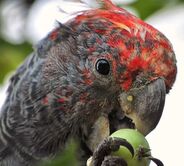
The Gang-gang Cockatoo habitat includes Nooramunga Marine & Coastal Park in south-eastern Australia. In the summer months, they can be seen soaring the summer thermals of the Strzelecki Ranges, where they breed in the tree-hollows of eucalyptus forests. Once breeding is finished they move closer to the coast, spending autumn and winter at lower altitudes.
At dusk they can been observed flying south-west across the Hedley area enroute to their night haunt.
At dusk they can been observed flying south-west across the Hedley area enroute to their night haunt.
Conservation
The Gang-gang Cockatoo was Listed as Endangered (Date effective 02-Mar-2022)
https://www.environment.gov.au/cgi-bin/sprat/public/publicspecies.pl?taxon_id=768
https://www.environment.gov.au/cgi-bin/sprat/public/publicspecies.pl?taxon_id=768
|
"The main factor that makes the species eligible for listing in the Endangered category is that the population has declined by approximately 69% from 1999 – 2019" Conservation Advice for Callocephalon fimbriatum (Gang-gang Cockatoo) DAWE
|
| ||||||
In The News
Gang-gang cockatoo to become threatened species after large drop in bird numbers
Cockatoo populations reduced after 2019-20 bushfires with decline expected to continue as climate crisis causes increased heatwaves
Follow the link to the Guardian
Photos used under Creative Commons from Rod Waddington sbittinger

